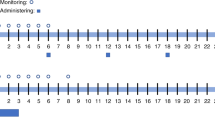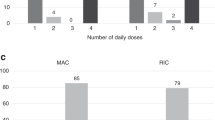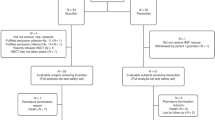Summary:
Pharmacokinetic and clinical outcome measures among three groups of patients undergoing hematopoietic transplant were assessed: group A: Parenteral busulfan (Bu) 3.2 mg/kg i.v. given qd, n=20; group B: parenteral Bu 0.8 mg/kg i.v. given every 6 h, n=11; group C: Bu 1 mg/kg p.o. given every 6 h, n=25. All groups received Bu over 4 days followed by Cy 60 mg/kg i.v. qd over 2 days; followed by an infusion of allogeneic stem cells. Median Bu clearance was 3.21 ml/min/kg and median daily AUC was 4071 μmol/min for the group A patients. The dosing formula for Bu i.v. qd was highly predictive of the AUC for patients whose mass ⩽IBW+20%. For patients of greater mass, the dosing formula uniformly resulted in lower-than-predicted AUC. Neurologic toxicity, hepatic toxicity, hematologic engraftment, and relapse at 100 days were comparable across all three groups. Severe AGVHD was least among group A, followed by group B when compared with group C. Bu i.v. qd is a safe and effective regimen for allogeneic transplantation and is at least clinically equivalent to every 6 h dosing schemes using either oral or parenteral Bu.
This is a preview of subscription content, access via your institution
Access options
Subscribe to this journal
Receive 12 print issues and online access
$259.00 per year
only $21.58 per issue
Buy this article
- Purchase on Springer Link
- Instant access to full article PDF
Prices may be subject to local taxes which are calculated during checkout
Similar content being viewed by others
References
Santos GW, Tutschka PJ, Brookmeyer R et al. Marrow transplantation for acute nonlymphocytic leukemia after treatment with busulfan and cyclophosphamide. N Engl J Med 1983; 309: 1347–1353.
Lu C, Braine HG, Kaizer H et al. Preliminary results of high-dose busulfan and cyclophosphamide with syngeneic or autologous bone marrow rescue. Cancer Treat Rep 1984; 68: 711–717.
Tutschka PJ, Copelan EA, Klein JP . Bone marrow transplantation for leukemia following a new busulfan and cyclophosphamide regimen. Blood 1987; 70: 1382–1388.
Clift RA, Buckner CD, Thomas ED et al. Marrow transplantation for chronic myeloid leukemia: a randomized study comparing cyclophosphamide and total body irradiation with busulfan and cyclophosphamide. Blood 1994; 84: 2036–2043.
Clift RA, Radich J, Appelbaum FR et al. Long-term follow-up of a randomized study comparing cyclophosphamide and total body irradiation with busulfan and cyclophosphamide for patients receiving allogeneic marrow transplants during chronic phase of chronic myeloid leukemia. Blood 1999; 94: 3960–3962.
Grochow LB, Jones RJ, Brundrett RB et al. Pharmacokinetics of busulfan: correlation with veno-occlusive disease in patients undergoing bone marrow transplantation. Cancer Chemother Pharmacol 1989; 25: 55–61.
Kashyap A, Wingard J, Cagnoni P et al. Intravenous versus oral busulfan as part of a busulfan/cyclophosphamide preparative regimen for allogeneic hematopoietic stem cell transplantation: decreased incidence of hepatic veno-occlusive disease (HVOD), HVOD-related mortality, and overall 100-day mortality. Biol Blood Marrow Transplant 2002; 8: 493–500.
Vaughan WP, Cagnoni P, Fernandez H et al. Decreased incidence of and risk factors for hepatic veno-occlusive disease with an IV busulfan (Bu) containing preparative regimen for hematopoietic stem cell transplantation (HSCT). Blood 1998; 92 (suppl. 1) (abstr#2121).
Jones RJ, Lee KS, Beschorner WE et al. Venoocclusive disease of the liver following bone marrow transplantation. Transplantation 1987; 44: 778–783.
Dix SP, Wingard JR, Mullins RE et al. Association of busulfan area under the curve with veno-occlusive disease following BMT. Bone Marrow Transplant 1996; 17: 225–230.
Copelan EA, Bechtel TP, Avalos BR et al. Busulfan levels are influenced by prior treatment and are associated with hepatic veno-occlusive disease and early mortality but not with delayed complications following marrow transplantation. Bone Marrow Transplant 2001; 27: 1121–1124.
De Lima M, Couriel D, Thall PF et al. Once daily intravenous busulfan and fludarabine and pharmacokinetic results of a myeloablative, reduced toxicity conditioning regimen for allogeneic stem cell transplantation in AML and MDS. Blood 2004; 104: 857–864.
Bhagwatwar HP, Phadungpojna S, Chow DS et al. Formulation and stability of busulfan for intravenous administration in high-dose chemotherapy. Cancer Chemother Pharmacol 1996; 37: 401–408.
Andersson BS, Kashyap A, Gian V et al. Conditioning therapy with intravenous busulfan and cyclophosphamide (IV BuCy2) for hematologic malignancies prior to allogeneic stem cell transplantation. Biol Blood Marrow Transplant 2002; 8: 145–154.
Shimoni A, Bielorai B, Toren A et al. Intravenous busulfan-based conditioning prior to allogeneic hematopoietic stem cell transplantation: myeloablation with reduced toxicity. Exp Hematol 2003; 31: 428–434.
Olavarria E, Hassan M, Eades A et al. A phase I/II study of multiple-dose intravenous busulfan as myeloablation prior to stem cell transplantation. Leukemia 2000; 14: 1954–1959.
Andersson BS, Madden T, Tran H et al. Acute safety and pharmacokinetics of intravenous busulfan when used with oral busulfan and cyclophosphamide as pretransplantation conditioning therapy; a phase I study. Biol Blood Marrow Transplant 2000; 6: 548–554.
Fernandez HF, Tran HT, Albrecht F et al. Evaluation of safety, efficacy, and pharmacokinetics of administering IV busulfan (Busulfex®) in patients with advanced hematologic malignancies undergoing stem cell transplant (SCT) [abstract]. Biol Blood Marrow Transplant 2001; 7: 71 (abstract 29).
Gordon N, Mullen CA, Tran H et al. Fludarabine and once-daily intravenous busulfan for allogeneic bone marrow transplantation for Chediak–Higashi syndrome. J Pediatr Hematol Oncol 2003; 25: 824–826.
Russell J, Tran H, Quinlan D et al. Once-daily intravenous busulfan given with fludarabine as conditioning for allogeneic stem cell transplantation: study of pharmacokinetics and early clinical outcomes. Biol Blood Marrow Transplant 2002; 9: 468–476.
Fernandez H, Tran H, Albrecht F et al. Evaluation of safety and pharmacokinetics of administering intravenous busulfan in a twice-daily or daily schedule in patients with advanced hematologic malignant disease undergoing stem cell transplantation. Biol Blood Marrow Transplant 2002; 9: 486–492.
Andersson BS, Thall PF, Madden T et al. Busulfan systemic exposure relative to regimen-related toxicity and acute graft vs host disease; defining a therapeutic window for iv BuCy2 in chronic myelogenous leukemia. Biol Blood Marrow Transplant 2002b; 8: 477–485.
Ljungman P, Hassan M, Bekassy AN et al. High busulfan concentrations are associated with increased transplant-related mortality in allogeneic bone marrow transplant patients. Bone Marrow Transplant 1997; 20: 909–913.
Bearman SI, Anderson GL, Mori M et al. Venooclusive disease of the liver: development of a model for predicting fatal outcomes after marrow transplantation. J Clin Oncol 1993; 9: 1729.
ESP Pharma, Inc. Busulfex® (busulfan) Injection [product monograph]. ESP Pharma, Inc.: Edison, NJ, 2003.
Przepiorka D, Khouri I, Ippoliti C et al. Tacrolimus and minidose methotrexate for prevention of acute graft-versus-host disease after HLA-mismatched marrow or blood stem cell transplantation. Bone Marrow Transplant 1999; 24: 763–768.
Thomas ED, Blume KG, Forman SJ . Hematopoietic Cell Transplantation. Blackwell Science: Malden, MA, 1999, pp 518–519.
McDonald GB, Sharma P, Mathews DE et al. Venocclusive disease of the liver after bone marrow transplantation. Hepatology 1984; 4: 116–122.
International Bone Marrow Transplant Registry Autologous Blood and Marrow Transplant Registry Statistical Center. Manual for Clinical Research Professionals. Instructions for Completing the 2002 CORE Insert 2002 COREFU Insert 2002 DCI Insert. Medical College of Wisconsin, Milwaukee, WI, 2003.
Pharsight, Inc. WinNonlin Professional version 4.0 [computer program]. Pharsight, Inc.: Mountain View, CA, 2002.
C Ediss Faculty of Pharmacy and Pharmaceutical Sciences. Lagran Pharmacokinetics software, Version 1.0 [computer program].: C Ediss Faculty of Pharmacy and Pharmaceutical Sciences: Edmonton, Alberta, Canada, 1991.
Slattery JT, Clift RA, Buckner CD et al. Marrow transplantation for chronic myeloid leukemia: the influence of plasma busulfan levels on the outcome of transplantation. Blood 1997; 89: 3055–3060.
Deeg HJ, Storer B, Slattery JT et al. Conditioning with targeted busulfan and cyclophosphamide for hemopoietic stem cell transplantation from related and unrelated donors in patients with myelodysplastic syndrome. Blood 2002; 100: 1201–1207.
Sandstrom M, Karlsson MO, Ljungman P et al. Population pharmacokinetic analysis resulting in a tool for dose individualization of busulphan in bone marrow transplantation recipients. Bone Marrow Transplant 2001; 28: 657–664.
Agresti A . An Introduction to Categorical Data Analysis. John Wiley & Sons, Inc.: New York, 1996.
Radich JP, Gooley T, Bensinger W et al. HLA-matched related hematopoietic cell transplantation for chronic-phase CML using a targeted busulfan and cyclophosphamide preparative regimen. Blood 2003; 102: 31–35.
Hassan M, Berg G, Ehrsson H et al. Pharmacokinetic and metabolic studies of high-dose busulphan in adults. Eur J Clin Pharmacol 1989; 36: 525–530.
Hassan M, Ljungman P, Ringden O et al. The effect of busulphan on the pharmacokinetics of cyclophosphamide and its 4-hydroxy metabolite: time interval influence on therapeutic efficacy and therapy-related toxicity. Bone Marrow Transplant 2000; 25: 915–924.
Slattery JT, Risler LJ . Therapeutic monitoring of busulfan in hematopoietic stem cell transplantation. Ther Drug Monit 1998; 20: 543–549.
Lindley C, Shea T, McCune J et al. Intraindividual variability in busulfan pharmacokinetics on patients undergoing a bone marrow transplant: assessment of test dose and first dose strategy. Anticancer Drugs 2004; 15: 453–459.
Grochow LB . Commentary: parenteral busulfan: is therapeutic monitoring still warranted. Biol Blood Marrow Transplant 2002; 8: 465–467.
Gibbs JP, Gooley T, Corneau B et al. The impact of obesity and disease on Busulfan oral clearance in adults. Blood 1999; 93: 4436–4440.
Ferrara JL, Cooke KR, Teshima T . The pathophysiology of acute graft-versus-host disease. Int J Hematol 2003; 78: 181–187.
Acknowledgements
We wish to thank the nursing staff of the Blood and Marrow Transplant Unit at the 4th floor Collins at Baylor University Medical Center for their diligent help and their care of these patients; also, I would like to acknowledge Heather M Houin for her editorial work, and ApotheCom Associates LLC for their expert assistance in the editing of this manuscript.
Author information
Authors and Affiliations
Corresponding author
Rights and permissions
About this article
Cite this article
Mamlouk, K., Saracino, G., Berryman, R. et al. Modification of the Bu/Cy myeloablative regimen using daily parenteral busulfan: reduced toxicity without the need for pharmacokinetic monitoring. Bone Marrow Transplant 35, 747–754 (2005). https://doi.org/10.1038/sj.bmt.1704871
Received:
Accepted:
Published:
Issue Date:
DOI: https://doi.org/10.1038/sj.bmt.1704871
Keywords
This article is cited by
-
Evaluation of different pharmacokinetically guided IV busulfan exposure ranges on adult patient outcomes after hematopoietic stem cell transplantation
Annals of Hematology (2023)
-
Population pharmacokinetic analysis of intravenous busulfan: GSTA1 genotype is not a predictive factor of initial dose in Chinese adult patients undergoing hematopoietic stem cell transplantation
Cancer Chemotherapy and Pharmacology (2020)
-
Once-daily i.v. BU-based conditioning regimen before allogeneic hematopoietic SCT: a study of influence of GST gene polymorphisms on BU pharmacokinetics and clinical outcomes in Chinese patients
Bone Marrow Transplantation (2015)



